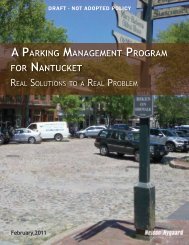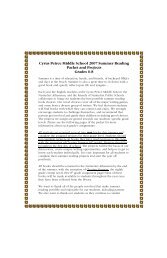Cyrus Peirce Middle School 2007 Summer Reading Packet and ...
Cyrus Peirce Middle School 2007 Summer Reading Packet and ...
Cyrus Peirce Middle School 2007 Summer Reading Packet and ...
You also want an ePaper? Increase the reach of your titles
YUMPU automatically turns print PDFs into web optimized ePapers that Google loves.
Civil Rights Movement are the focus of this remarkable book. History is told through theexperiences of two young men of disparate backgrounds, one black John Lewis, the other whiteJim Zwerg. A foreword by each man precedes chapters that compare <strong>and</strong> contrast their families,childhoods, <strong>and</strong> teenage years, <strong>and</strong> the events leading up to, <strong>and</strong> their participation in, thehistoric rides of the early 1960s. Dramatic black-<strong>and</strong>-white photographs, accompanied by clear,engaging captions, support the text. Each of the seven chapters is preceded by a full-pagephotograph. Bausum's narrative style, fresh, engrossing, <strong>and</strong> at times heart-stopping, brings thestory of the turbulent <strong>and</strong> often violent dismantling of segregated travel alive in vivid detail.Genius: A Photobiography of Albert Einstein by: Marfe FergusonWhile the myriad photographs are fascinating, the bigger draw here is the wonderfully simpleexplanations of some of Einstein's theories. For example, in clarifying the physicist's quantumtheory of light, Delano says, "Simply put, Einstein showed that photons in the light beam knockthe electrons out of metal." And, to make the concept of spacetime easier to underst<strong>and</strong>, sheasks readers to contemplate spacetime as a trampoline with a bowling ball resting on it. Thisvisual perception helps to make the theory underst<strong>and</strong>able for all students. The black-<strong>and</strong>-white<strong>and</strong> sepia photographs follow Einstein from boyhood to old age <strong>and</strong> show him in a variety ofsettings: at the blackboard, delivering a speech, taking the oath of U.S. citizenship, in hisPrinceton home with children who survived the Holocaust, <strong>and</strong> so on. Many have appearedelsewhere. Cartoon illustrations add to the clarity of the very readable text. Personal thoughts<strong>and</strong> feelings abound. To make Einstein human to the audience, his mistakes are mentioned, aswell as his celebrity. Complete quote sources are appended. An introduction by EvelynEinstein, the scientist's gr<strong>and</strong>daughter, is included. This entertaining effort displays clarity <strong>and</strong>intelligence. It has plenty of information for reports <strong>and</strong> is also a good choice for browsing.Hope for the People by: Cesar ChavezThe son of poor Mexican Americans, Cesar Chavez grew up in grinding poverty. In 1962, he setout to do what many before him had tried <strong>and</strong> failed to do -- organize a trade union for farmworkers. With courage <strong>and</strong> determination, he transformed the plight of the workers into aninternational cause.Into Thin Air by: Jon KrakauerInto Thin Air is a riveting first-h<strong>and</strong> account of a catastrophic expedition up Mount Everest. InMarch 1996, Outside magazine sent veteran journalist <strong>and</strong> seasoned climber Jon Krakauer on anexpedition led by celebrated Everest guide Rob Hall. Despite the expertise of Hall <strong>and</strong> the otherleaders, by the end of summit day eight people were dead. Krakauer's book is at once the storyof the ill-fated adventure <strong>and</strong> an analysis of the factors leading up to its tragic end. Writtenwithin months of the events it chronicles, Into Thin Air clearly evokes the majestic Everestl<strong>and</strong>scape. As the journey up the mountain progresses, Krakauer puts it in context by recallingthe triumphs <strong>and</strong> perils of other Everest trips throughout history. The author's own anguishover what happened on the mountain is palpable as he leads readers to ponder timelessquestions.Life is so Good: by George DawsonA 101-year-old retired laborer who enrolled in a literacy class near his Dallas, Tex., home at theage of 98, George Dawson now reads <strong>and</strong> writes on a third-grade level. From Dawson's eloquentwords, co-writer Glaubman, a Seattle elementary school teacher, has fashioned two engrossingstories. First is the inspiring saga of how someone who was the gr<strong>and</strong>son of a slave managed tonavigate the brutally segregated small Texas town of Marshall, where Dawson was born, withoutlosing his integrity or enjoyment of life. Although he worked from an early age <strong>and</strong> was neverable to attend school, Dawson credits his strong family, especially his father, for giving him theskills to survive. His father told him to work hard, to do no wrong <strong>and</strong> always to avoid troublewith white people--advice that was brutally underscored the day he <strong>and</strong> his father witnessed awhite mob lynching a black neighbor. The other theme running through these recollections is





